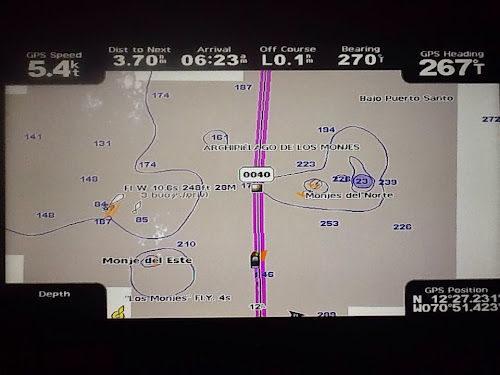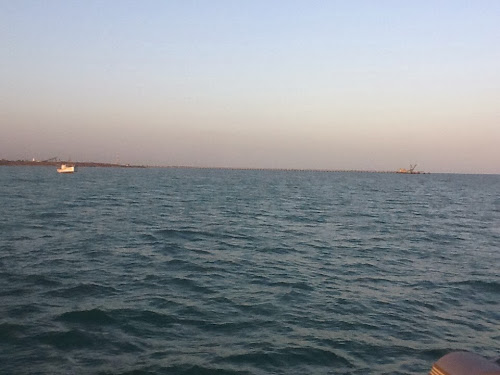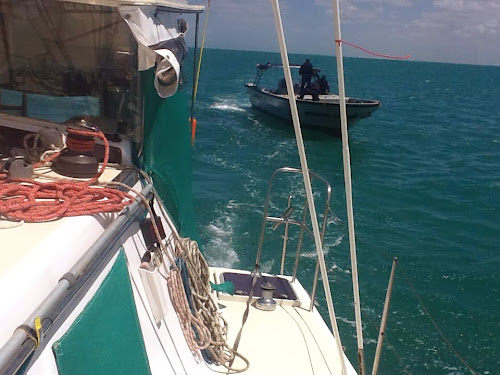Kuhela is a 45 foot Royal Cape catamaran built in South Africa in 2002-3. Kuhela is a Hawaiian word meaning, "To rise up and move along as the swell of the ocean; to be one with the sea". Harry "Pete" and Linda Arnold are Master and First (only) Mate, respectively.
Wednesday, February 19, 2014
Aloha, Aruba
Good bye to the dust and mud it creates. Good bye to the one way streets and the circles they create. Good bye to the green grass (I hope) growing on the sugar scoop steps. We're off... All the repairs that could be made have been. The auto pilot is holding, so far and we haven't run into anything.
The Oranjestad tram that runs from the cruise terminal to old town.
We left the Renaissance Marina at around 1230. We cast off the dock lines holding us to windward on another boat in the slip next door and pulled into the basin just in front of us with the engines. Linda pulled in the dock lines while I steered. Once we were in front of our neighbor, I put her ( that's Kuhela, not Linda) tin neutral, ran forward and pulled up the anchor. We turned into the wind and Linda, now at the helm, kept us going forward as the chain rolled in. Anchor's away, Linda turns us, and we head out the channel for Barcadera: up wind and wave (East). It's blowing 20+ and the seas crashing over the bow are 5-6 ft. Barcadera is where we have to come along side the commercial pier to go into Customs and Irritation to check out, captain only, no Commadores allowed. Takes about 20 minutes filling out papers that I did checking in (no copier, I guess) and we're released to our next port: Cartagena, Columbia.
From a women's point of view: Harry didn't mention that our neighbors in the Marina were over million dollar boats and 90 feet long. With the wind blowing 20 (great for sailing) it wasn't such an easy task getting out of the slip. Fortunately, we only came as close as about 4 feet. The big plus was having our Aruban mechanic (and now friend) helping us cast off the lines. And now, about customs - if you read the last blog you may remember I did not do so well climbing out of the dingy onto the dock. There were huge tires I had to climb with the waves crashing into the side of the dingy and I was slammed against the tires as the dingy flew out from under my feet . It wasn't a pretty sight. Picture a 65 year old hanging on and trying to pull herself up 5 feet over the tires onto the dock - not graceful!! So, after 4 weeks in Aruba, my rib cage has recovered and the pain is gone so you can imagine how I felt going again to customs. Oh, but of course, this time we would be on the boat and I could step onto the dock. HAH!!!! Too far to even jump, as I would have to hang onto the top set of tires and climb over. SO. I told Harry to tell them to come to me if they wanted to see me. Turns out they didn't even care.
We make our 1400 est. departure, haul up the main sail, turn starboard (left), and head out for the high seas. Not so high, thankfully, as we were lead to believe by the grib (wifi weather files) files: 1-3ft. seas and 10-16 knot winds. We sail down wind, wing and wing (that's the main out to starboard and the jib - that' the smaller sail at the bow - polled out to port. Dolphins follow us in our bow wave for a good half hour, breaking off when we pass two tankers transferring cargo right in the middle of our course (rumb line) for Bahia Honda, our first rest stop in Columbia. We'll stop there early tomorrow morning (looks like 0530 as we're making much better time than we planned: 6.9 v. 6 knots); or if we aren't pooped, continue on to Manaure another 58 nautical miles further on. We'll see tomorrow.
The sun is setting and we will arrive at some islets, Monjes del Este, at around 2200. Yah, after dark: lousy planning I'd say. I learned why my auto pilot, Mona, makes so much noise - from the start, even. Seems the bit.h had a leak in a hydraulic line or two. With my trusty, dusty little adjustable wrench, I gave her a tweak 'cause we had noticed that in addition to her moaning she was loosing fluid, not much, but some. Now she's quiet and keeping her fluid to her self. Oh, joy and rupture!
Dawn: COLUMBIA! Wow, how under impressive: flat, dersert-like Aruba-' few lights, one ship anchored at Badia de Portete probably to load coal from the largest open pit in South America (Columbia, anyway). Winds are under 10 with a following 2' sea. Definately unexpected and forecasted: winds 20-25, seas 6'+. Happy days are here again!
We bypassed Bahia Honda and re-routed for Manaure, important for its salt flats and propane fields. Woo-woo. We should get there at around 1500, drop sail, and anchor. It's a run of 160 nm and 25 hours. Pretty good we think for our first leg.
"What in the world do you do while underway? " you might ask. Fix things that break is number 1. As this is a boat in a very caustic environment, s..t happens with some regularity; maybe it's just another way to set the sails, like learning how to use the whisker pole: a telescoping pole attached to the mast that clips on to the in halyard and holds the jib out over the side keeping it from collapsing. Standing watches and looking for flotsam and other vessels; adjusting the course due to changes in wind direction and currents; keeping an eye on the depth sounder when we're in shallow (less than 50') waters, and a lot of reading both easy as well as educational (weather forecasting, storm tactics, cruising guides, etc.). And playing Spider and backgammon (Harry) on our computers which for Harry is an idiot player. Beats being a couch potatoe by just a little.
Manaure, Columbia is a salt shipment "pier" and conveyor/shoot off the beach. Nothing else but a few isolated houses. Arrived here, it's a lee shore, at 1500, put down the anchor, and that's it. No place to land even if we wanted to. What a terrible anchorage even for the fishermen who have to swim out to their boats morning and night. Winds were 20+ knots with a 2-3' chop bouncing us around most of the night.
Salt conveyor in background on a surprisingly calm morning after.
Manaure Playa (beach) with the fishing boats anchored off. This morning was clam with a light breeze which aided in putting the baton (a stiffening rod running fore and aft sewn into a pocket in the main) back in the main sail.
The best was yet to come.
The morning of the second day is warm with blue sky's, some puffy white coluds, wind 10-12 knots and virtually flat seas; like yesterday. We're off at 1100 heading for Bahia de el Rodadera some 120 nm further down the coast and just past Santa Marta. The headland just before Santa Marta has a reputation for some serious winds and seas. We'll be taking it very early in the morning tomorrow. Hopefully it's reputation will not survive the wee hours. I'm at the helm (driving, steering sorta) watching for Manaurian fishermen and dodging the two oil drilling (or maybe just pumping now) platforms named Chuchupa A & B some 17 mn ahead. We'll pass just left of them thru a restricted corridor which shows up on the chart as two, red dotted lines.
I can't believe I'm COLD! All afternoon while sitting at the helm with a 17-29 knot wind running over me and the thermometer showing 79* and I'm cold. Linda says she's cold, too, so I' apparently not coming down with anything. Wow: long pants and fleece jacket and definately in order.
It's 0140 on Wednesday the 19th, our second overnight passage. Linda has gone down below for a well deserved rest. We're off Cabo San Juan de Guie which is the beginning of the headland E of Santa Marta in the Tayrona National Part. This is the area noted for its huge seas and high winds that we are every apprehensive about. So far, knock on wood, following seas are 7-8' and winds are 17-20 knots off the shore to the port (S). We are running with only the main up trying to slow down so we don't get to our next anchorage, Bahia de el Rodadero, before dawn.
What a difference 2 hours and 14 nm makes: gusts to 41+ knots, seas to 10', and a wind shift. The boat was over powered and turned into the wind which it's supposed to do. Managed to get the sail down - thankfully the jib was already rolled on - and regained control with the engines. We were far enough off the coast that at least we didn't end up there. The short hop around Isla de Aguja saw us to calmer waters until we got past Santa Marta where the winds went back to 30+ knots. We turned around and beat a hasty retreat back to Santa Marta where we had to do circles for 2 hours before we got a port clearance to enter. We got fuel at the marina and had to check-in. Rob and Lauren lucked out bluffing their way thru without checking in. Here, not so.
Here's the Army dude that boarded us near Manaure. Very friendly with a smattering of English. Took pictures of everything even under my wall-hung tool chest?????
And his cutter...
Subscribe to:
Post Comments (Atom)








Such dedicated bloggers. This is such a tough time of year. I am very glad read about this blog i am sharing great information with you.
ReplyDeletehttp://www.aspenpowercatamarans.com/pages/Welcome.html